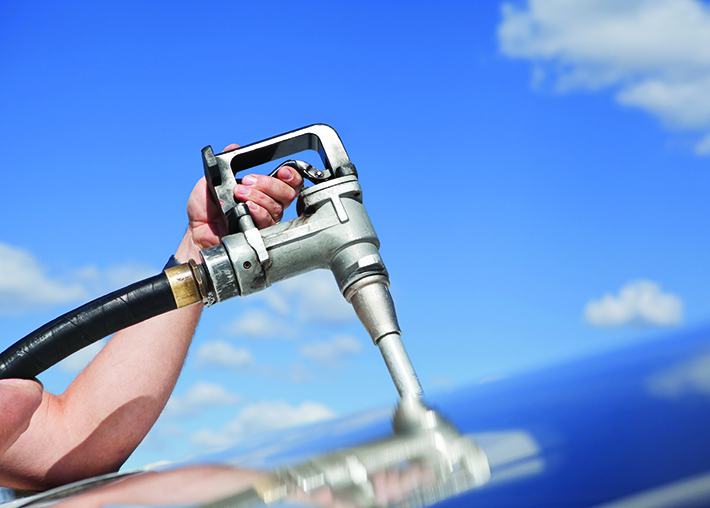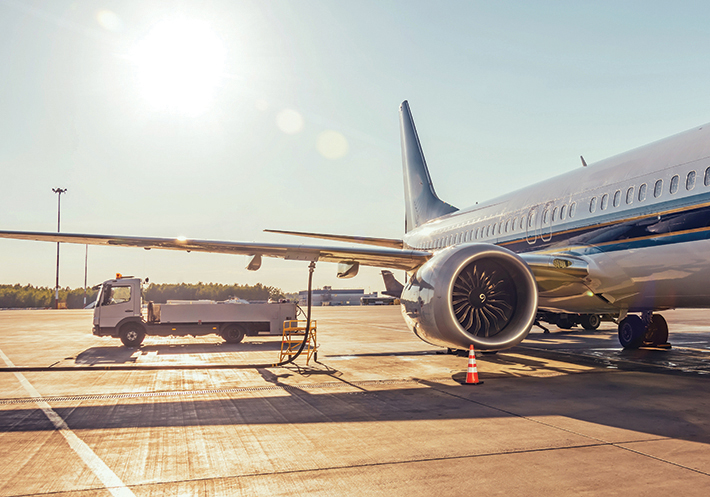
Fueling the Future of Aviation
When boarding a flight, few passengers pause to consider how much fuel their trip will require. However, according to statistics and market insights provider Statista, that number is large – enormous, in fact. In 2019, commercial airline flights consumed 95 billion gallons of fuel worldwide. And despite a 60 percent drop in air travel during the COVID-19 pandemic, aviation fuel producers such as Shell Aviation predict a return to pre-pandemic fuel consumption levels within the next year.
Not only the demand but also the cost for aviation fuel is rising. In March 2023, the U.S. Bureau of Transportation Statistics reported a 40.9 percent increase in the price of aviation fuel per gallon from January 2022 to January 2023 and a 70.6 percent fuel expenditure increase from January 2019 to January 2023 for airlines in the U.S.
Accelerated demand and cost for fuel comes alongside a growing unease about supply chains, global instability, and climate change, all of which have prompted the aviation industry to reconsider its dependence on petroleum-derived energy. As it shifts away from kerosene-based jet fuel toward synthetic fuels, the industry has enlisted the assistance of ASTM International’s committee on petroleum products, liquid fuels and lubricants (D02). Formed in 1904, the committee’s focus includes the qualification and certification of synthetic aviation turbine fuels.
READ MORE: The Promise of Urban Air Mobility
“The move toward synthetic aviation turbine fuels was first initiated by the U.S. Air Force in the mid-2000s,” says Mark Rumizen, chair of the subcommitte on aviation fuels (D02.J0). “Their primary concern was supply security. The environmental community picked up on synthetic fuel and that’s been the primary motivation for some time — environmental concerns. However, with increasing political support for these fuels, the military has once again taken a leadership role.”
Evaluating New Aviation Fuels and Additives
To standardize the assessment of synthetic aviation fuels (SAFs), the subcommittee on additives and electrical properties (D02.J0.04) developed the standard practice for evaluation of new aviation turbine fuels and fuel additives (D4054). It guides the alternative fuel or fuel-additive producer through the testing of fuel properties, composition and performance, and periodic, rigorous reviews with aviation fuel stakeholders such as aircraft engine manufacturers.
“D4054 is a process standard; it defines the process,” says Alyssa Roche, secretary of the subcommittee on synthetic aviation turbine fuels (D02.J0.06). “D7566 is a product standard that defines the end product — the result of the process — and what it’s to look like when it’s blended into jet fuel as well as the component. The users look at D7566.”
In 2009, this subcommittee published the aforementioned specification for aviation turbine fuel containing synthesized hydrocarbons (D7566). The specification defines the minimum property requirements for aviation turbine fuel containing synthesized hydrocarbons and lists acceptable additives for use in civil aviation. It is applied to synthetic blending components that have been evaluated and approved through the use of D4054. D7566 has been incorporated into the U.K.’s Defence Standard 91-091 for aviation turbine fuel and is also the standard to which Europe and Asia are purchasing aviation fuel.
Currently, the standard features seven annexes. An annex is an approved path, or method, of creating a synthetic blending component to add to conventional jet fuel, which results in a fuel that complies with the requirements of the standard specification for aviation turbine fuels (D1655). Each annex includes the definition of allowable feedstocks, conversion process, and blending component attributes and blending criteria. An eighth annex for alcohol-to-jet synthetic paraffinic kerosene (ATJ-SPK) with aromatics is being considered under a revision (WK78417). The work item addresses Swedish Biofuels’ ATJ-SPK application for approval as a D7566 aviation kerosene.
“The only global specification standard for synthetic aviation turbine fuel is D7566,” says Dr. Gurhan Andac, engineering technical leader for aviation fuels at GE Aerospace. He is also the chair of the subcommittee on synthetic aviation turbine fuel (D02.J0.06). “The other standards point to D7566. There aren’t seven fuels in the standard. Instead, there currently are seven synthetic production pathways, defined and controlled by individual annexes in D7566, to produce synthetic blending components that result in the same Jet A or Jet A-1 fuel the industry has been using, when blended with conventional blending component up to the allowed blending limit. If a synthetic blending component meets the requirements of the standard and its respective annex, it is then blended with the conventional blending component. In turn, if the final blend meets comprehensive Jet A or Jet A-1 requirements, it is reidentified as a D1655 Jet A or Jet A-1.”
Among the seven annexes, five have 50 percent maximum blending with Jet A or Jet A-1. Two have 10 percent maximum blending. These percentages represent the amount of a synthetic blending component that can be added to conventional jet fuel to create an alternative fuel that meets certification requirements and operates seamlessly within an aircraft.
The subcommittee has also revised annex A5 — alcohol-to-jet synthetic paraffinic kerosene — to include isobutene, the deoxygenated equivalent of the alkyl alcohol isobutanol, as an approved starting material. The standard specification for aviation turbine fuel containing synthesized hydrocarbons (WK71952) covers a new process developed by the French company Global Bioenergies that mirrors the isobutanol to jet fuel route.
 A renewed interest in sustainable aviation fuels has sparked the need for new standards.
A renewed interest in sustainable aviation fuels has sparked the need for new standards.
Process and Product
In order to be deemed a one-for-one substitution for petroleum-derived fuel, alternative aviation fuel – or “drop-in fuel” – must meet the property requirements of D1655. The specification outlines the minimum property requirements for Jet A and Jet A-1 fuels, such as composition, volatility, fluidity, combustion, corrosion, thermal stability, and contaminants. It also lists acceptable additives for use in both commercial and military aircraft. Approved in 1959, the standard is utilized globally by purchasing agencies.
Only after meeting the specification for aviation turbine fuel containing synthesized hydrocarbons (D7566) does a drop-in fuel fulfill the requirements of D1655.
“With respect to the concept of SAFs, you can’t really divide D7566 and D1655,” says Steve Csonka, executive director of the Commercial Aviation Alternative Fuels Initiative (CAAFI) and D02 committee member. “D7566 is the qualification that we refer to. It defines how someone can produce a synthetic aviation turbine fuel blending component using an alternative pathway. At the end of the day, though, we’re after a blended or perhaps 100 percent synthetic fuel that meets all the properties of D7566 and then D1655.”
The subcommittee on jet fuel specifications (D02.J0.01) has balloted an addition to a co-processing annex (WK78597) in D1655. At present, the co-processing of non-conventional feedstocks only involves triglycerides, fatty acids, and fatty acid esters or Fischer-Tropsch liquids, as cited in annex A1 of D1655. The co-processing of another feedstock — synthetic hydrocarbons derived from previously hydroprocessed fatty acids and fatty acid esters — would offer another means to more renewable content in jet fuel.
Considerations and Challenges for SAFs
As the subcommittees work to expand the qualification and certification of alternative aviation fuels, challenges and considerations do arise. Among the factors impacting their work is time. In the past, testing of synthetic fuels has taken several years. This is due to the comprehensive nature of the test program outlined in the standard practice for evaluation of new aviation turbine fuels and fuel additives (D4054).
“Data collection is a tiered approach so we would look at fuel properties in Tier 1 and Tier 2, conduct industry subcomponent and component tests to establish compatibility in Tier 3, and carry out system-level testing such as engine tests and flight tests in Tier 4,” says Andac. “The promoter of the candidate fuel works with various entities — OEMs, government partners, the Clearinghouse. After the data is collected, there is a robust review process. All of this work can be resource intensive in terms of cost and time. However, whatever is required will be completed to ensure that the product is safe jet fuel, fit for use in aviation.”
The D4054 Clearinghouse works with alternative fuel producers on the testing and validation of new aviation fuels. Coordinated by the University of Dayton Research Institute (UDRI), it assists any aviation fuel producer who wants to go through the ASTM qualification process and provides procedure management. The Clearinghouse is sponsored by the Federal Aviation Authority (FAA) and supported by the FAA’s Center of Excellence for Alternative Jet Fuels and Environment.
To address the issues around time and timeliness, the Clearinghouse offers a “Fast Track” program. Created by the UDRI, FAA, and ASTM, the Fast Track speeds up the approval process for synthetic fuels that possess composition and properties similar to conventional jet fuel. With the Fast Track, the process could take as little as one to two years.
In addition to time, resources can be a hurdle. “From a standards perspective, the biggest challenge is getting the aviation-fuel community to apply the necessary resources to do the rigorous and extensive review that’s required,” says Rumizen. “Because we want to make sure that the fuels are safe, the engine aircraft manufacturers have to put a lot of time into reviewing the data. You’re talking about companies that don’t make fuels as a business. They make airplanes. They make engines. To support this industry takes a lot of voluntary technical resources and dedication from the engine aircraft manufacturers.”
FOR YOU: Making Autonomous Flight a Reality
Financial resources are likewise a concern. Producers must ensure that the fuels are reproducible at a reasonable cost. Safety, though, is the ultimate consideration. “Flight safety is our number-one priority,” says Roche. “It’s not like with your car. If you have something in the fuel and the engine doesn’t work, you can pull over on the side of the road. There are no shoulders in the sky. We need to ensure flight safety with these new fuels.”
A Cleaner, Brighter Future
The Air Transport Action Group (ATAG) indicates that 490,119 commercial flights have operated on alternative aviation fuel since 2011. The number of flights is updated daily by ATAG. In 2021, the airline industry vowed to reach net-zero carbon emissions by 2050, a vow that it could reach by switching from conventional to synthetic aviation fuel. The International Air Transport Association (IATA) estimates that this change could result in a 65 percent reduction in emissions, propelling the airline industry closer to its net-zero goal. What does this increased interest in synthetic fuels mean for the producers? There will be a push to ramp up production of drop-in fuels and also a move toward 100 percent synthetic fuel.
“We likely need to get to 100 percent drop-in SAF sooner rather than later and there’s an effort underway to do that,” says Csonka. “Blending requires time, effort, resources and, typically, can increase price and carbon footprint — all things that we should be focused on reducing, if we can. The concept of being able to produce 100 percent synthetic that doesn’t require blending is something to which we aspire. Over the last two years, a lot of work has been done with respect to demonstration activity around 100 percent synthetic fuels, and crafting a D4054 methodology to allow such, so it’s possible for us to have a specification change adopted in 18 months for 100 percent [synthetic] in D7566.”
Roche adds, “We are evaluating a significant number of potential new pathways to produce alternative jet fuel, which is groundbreaking. Jet fuel has been one product defined for more than 70 years. All of a sudden, in the last decade, we’re looking at 10 to 20 new variations. It’s phenomenal. Everyone wants to support a cleaner, brighter future and we’re committed to finding a way to do that.” ■
Kathy Hunt is a U.S. East Coast-based journalist.
 SN Home
SN Home Archive
Archive Advertisers
Advertisers Masthead
Masthead RateCard
RateCard Subscribe
Subscribe Email Editor
Email Editor